“Pain and fear, pain and fear for me, alive or dead, no hope, no hope”, The life and adventures of Nicholas Nickleby ; The adventures of Oliver Twist / by Charles Dickens ; with fifty-nine illustrations by F. Barnard [for the first work] ; with twenty-eight illustrations by J. Mahoney [for the second work]. – London : Chapman and Hall, [1875]
This is the final in a series on Planet of the Humans. The other posts are here:
Post 1 – on the myths and misunderstandings in the film
Post 2 – on where we’re at in 2020, with climate and clean tech
It’s sad, but there’s no real end to the litany of things that threaten to derail the effort to uncouple human life from the burning of fossil fuels. For a while, it was at least simple. Moustache-twirling top-hatted fossil fuel execs running comically sinister astroturfing to scare us into hating alternatives was the norm.
Today, the call is coming from inside the house. You can tell something bad is happening because there’s a whole lot of misinformation and deception flying around, and a whole lot of people are trying to excuse it as acceptable.
Lies are glimpses of feeling; surface markers of some deeper sentiment taking shape and demanding to be fed. It got worse in the past week, and we need to figure out why. So please join me, and we’ll get to the bottom of it.
The cows are returning to the sea
A few weeks back, false claims of the natural world healing due to COVID-19 lockdowns spread virally. Swans that were always present in Venice were falsely framed as ‘returning’. Dirt settling on the floor of Venetian canals (instead of being whipped up by boats) was presented as ‘less pollution’. Paired with these memes was a simple explanation of the feeling those lies were fuelling: ‘Nature is healing. Humans are the virus, and corona is the cure!’. Mercifully, it became a widely mocked meme inspiring its own format of joke:
In parallel to claims of wildlife returning and nature ‘healing’, the pandemic has been touted as the cure to the climate problem.
As I wrote, this badly misdiagnoses the problems of climate change and pollution. Coronavirus will lead to a drop in emissions, but the coupling between human existence and fossil fuels will have not been broken. To break this chain requires enormous quantities of hard work, sacrifice, effort and collective action.
The latest data show that the predicted drop in emissions is likely to be the biggest ever – but still badly insufficient. The drop so far in carbon emissions is so small that it was immediately subsumed within the natural variability in those atmospheric levels, and it’s predicted to be tiny for the whole year. Readings of atmospheric concentrations of CO₂ at Mauna Loa observatory just hit their highest values ever recorded.
Nature is not healing.
 The predicted drop in 2020’s emissions. Source – IEA
The predicted drop in 2020’s emissions. Source – IEA
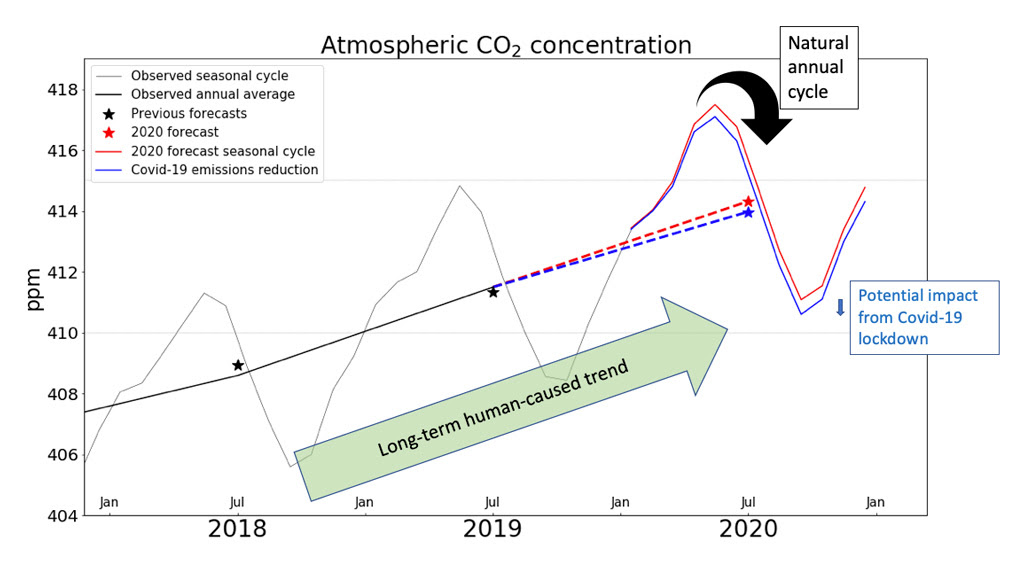 And the predicted impact on atmospheric CO2 concentrations, by Carbon Brief. “An analogy is filling a bath from a tap. If the tap represents CO2 emissions, and the water level in the bath is CO2 concentrations, while we have slightly turned the tap down temporarily, water is still flowing into the bath and so the level is still rising. To slow climate change, the tap needs to be turned right down – and permanently”
And the predicted impact on atmospheric CO2 concentrations, by Carbon Brief. “An analogy is filling a bath from a tap. If the tap represents CO2 emissions, and the water level in the bath is CO2 concentrations, while we have slightly turned the tap down temporarily, water is still flowing into the bath and so the level is still rising. To slow climate change, the tap needs to be turned right down – and permanently”
The pretence that coronavirus constitutes effective climate action is used to service a singular worldview: ‘human presence is the thing that is damaging the planet’s environment’. It is people that cause harm, and so people being locked in their homes must be framed as ‘healing’.
‘We are the virus’ is meant literally. A virus cannot change its ways, or alter its consumption. It cannot figure out a better way to live. It is a destructive automaton. It is a message of hopelessness, framed in the language of hope.
Nothing is going to work
A new documentary released by Michael Moore, Jeff Gibbs and Ozzie Zehner, Planet of the Humans, slots neatly into pre-existing demand for content that uses misinformation to frame humanity as a virus.
Part of reason it serves this purpose so well is that the density of falsehoods is incredible. Every re-encounter brings a new discovery. It is the gift that keeps on taking.
Since I published my first post on this, a litany of new errors, has emerged, partly covered here. In further interviews, the filmmakers botch the basic energy math even worse than the film. One scene, where it’s alleged solar enthusiasts ‘faked’ solar power for a festival was, it turns out, seemingly filmed in 2005 (two years prior to the release of Apple’s iPhone). Another, larger event presented as being falsely powered by a nearby solar field was in 2015 (Moore says it was ‘last year‘), and that solar field was only ever marketed by organisers as powering a small nearby pavilion.
One interviewee, Richard York, whose research suggesting renewables don’t displace fossil fuels was featured in the film, has since told media that “over the past decade, there have been more serious efforts”. The filmmakers had erased the date on the 2012 paper from the graphic on screen. Another interviewee, Richard Heinberg, revealed his interview occurred in 2009, 11 years prior to the release of the film.
The deceptions in the film build towards a single claim about renewables: they are technically incapable of decreasing emissions. They pile on top of existing output instead of cutting downwards, they encourage over-consumption and the fossil fuels required to build them are far greater than anything they could displace.
It’s all wrong. The past decade has proven that renewables can kill coal, and increasingly, gas too. 2019 was, in fact, the first year that low carbon sources out-generated coal:
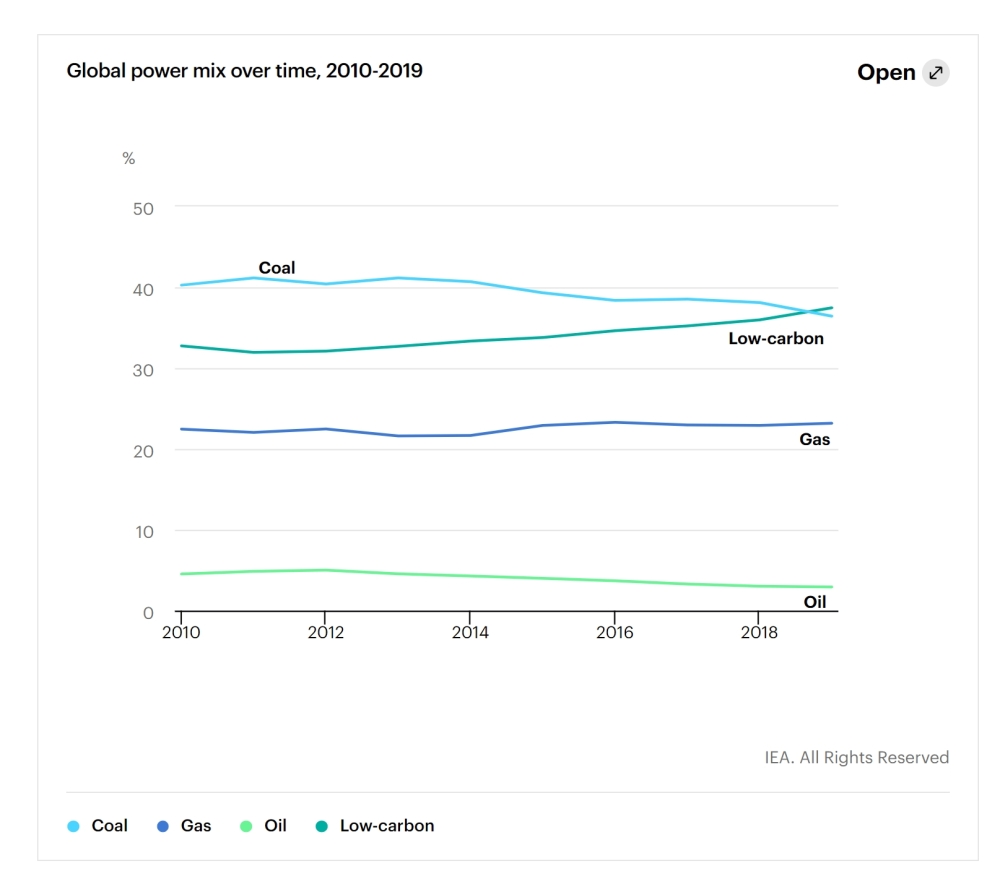 ‘Low carbon’ = wind, solar, hydro, nuclear, other. Source IEA
‘Low carbon’ = wind, solar, hydro, nuclear, other. Source IEA
It is not smooth, or simple, and it will get harder. Renewables got efficient and cheap, but they need to be integrated into grids in large volumes. They need to fulfil their potential of democratisation and distribution. More importantly, those who build it face the challenge of slotting into communities, landscapes, natural areas and cities with maximum respect and minimum impact. On top of all that, every megawatt hour is a bloody fist fight with panicked, powerful incumbents.
But the fact that there is still plenty of hard work to do does not take away from the fact that the past ten years proved that the machines do what it says on the god damn box.
The filmmakers complain that the mineral and mining footprint for things like electric vehicles is non-zero. This is true of any manufactured object, so their argument is, very simply, the disavowal of any technology, of any type, scale and ownership, for any component of climate action. Community owned wind? Not allowed. Rooftop solar? It’s made from quartz, so no. Low income electricity bill reduction through locally-owned batteries? Not a chance; lithium is mined by skinny kids. Didn’t you see the montage?
The oft-repeated gripe the filmmakers cite is “the story that climate change plus green technology equals were saved. It’s not the correct story”. But no one is telling this tale. They are shadowboxing their own imagined parody of environmentalism.
The only explanation for this weird faux-argument is that wind and solar were prominent in the early 2010s. Electricity is the fruit that hangs lowest on the list of climate actions, and wind and solar shot ahead of competitors around 2005 – 2010.
Everyone else moved on. A variety of tools form a major part of the plans of nearly everyone playing in this space. The International Energy Agency’s ‘Sustainable Development Scenario’ lays out one potential mix of actions to get us where we need here:
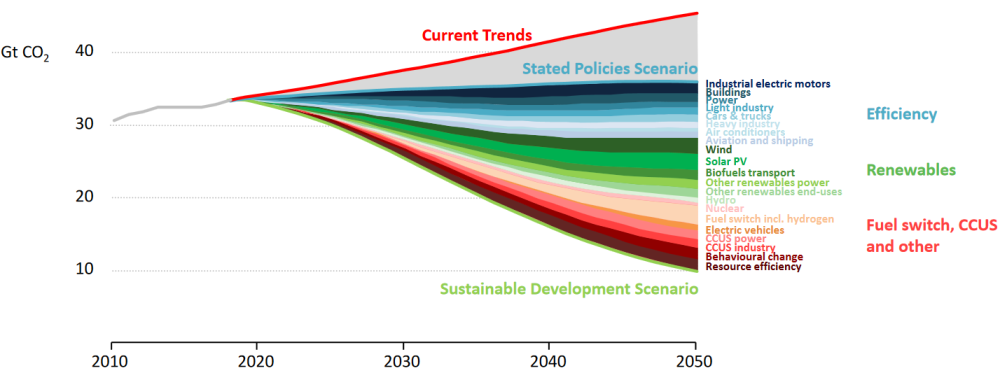 Reducing consumption is a major part of climate action, even in models by relatively conservative organisations like the IEA. It is not the only plan, and it has its flaws, but is shows that no one is proposing a ‘technology only’ approach.
Reducing consumption is a major part of climate action, even in models by relatively conservative organisations like the IEA. It is not the only plan, and it has its flaws, but is shows that no one is proposing a ‘technology only’ approach.
Climate-solutions-hitting-each-other-in-the-face is a bad habit that crops up around the big climate egos. People clutch their preferred thing with such intensity that they perceive all others as enemies, just as vile as fossil fuels. In this case, the filmmakers can’t advocate for reduced consumption without also advocating for taking an axe to the machines. But the viral reception to this film suggests something far deeper and far more significant than scrappy fights between the coloured strips on the chart above. The misinformation was feeding something big.
The big picture is bad too
Many reactions to my countering of the myths argued I’d missed the broader message of the film. This is true. I was focused on the smoke, not on the fire.
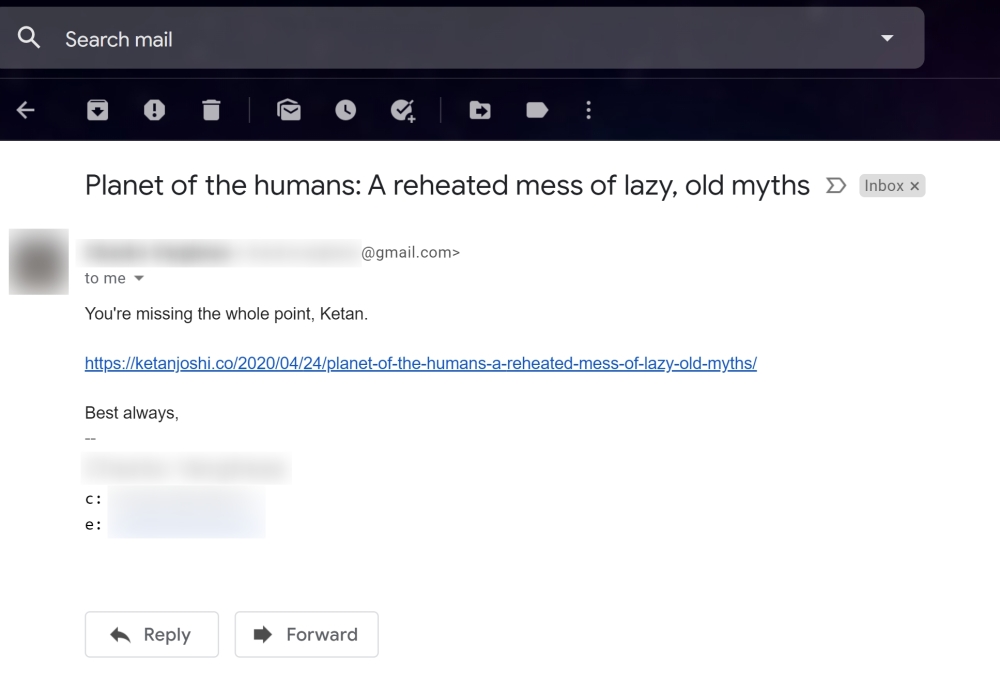 ‘best always’
‘best always’
The ‘bigger picture’ of this film seemed like a Jackson Pollock painting. There are mentions of growth, consumption and population, but no real clarity or insight. It did not seem to have a core message; so much so that its ambiguity meant it drew support from environmentalists, conservationists, anarchists, anti-capitalists, pro-capitalists, anti-growthers, pro-growthers, climate deniers, fossil fuel advocates, nuclear advocates and a scattering of edgelords worried they’d miss out.
It is a mess, but there are scraps in there for everybody with sufficiently low standards to feed on.
After some time, I think I the big picture finally resolved. The litany of attacks on actions – wind, solar and the hard work of environment groups – are building towards a clear conclusion. It is not about capitalism or consumption. The film’s core message is that we are invasive cells, breeding rapidly and programmed to destroy. We are the virus. The planet has a bad case of the humans.
“We’re kind of like cockroaches on the planet”, one vox-pop subject tells the director, in the film’s opening seconds. “Not being judgemental or trying to play God, but we’ve got to deal with population growth”, an anti-wind farm protester declares. “Without seeing some sort of major die off in population, there’s no turning back”, anthropologist Steven Churchill adds, later on.
Population growth is present in this film to serve this broader narrative. One graphic shows what is presumably a ‘forecast‘ shooting up to 60 or 70 billion people within a few years. Just like the exponential growth of a virus; something we know far too well this year.
Except, the United Nations predicts population growth is slowing, and will peak at 11 billion by the end of the century. Again, misinformation serves to feed the feeling, with enough pseudoscientific information to spark emotion but nowhere near enough specificity to inform the viewer.
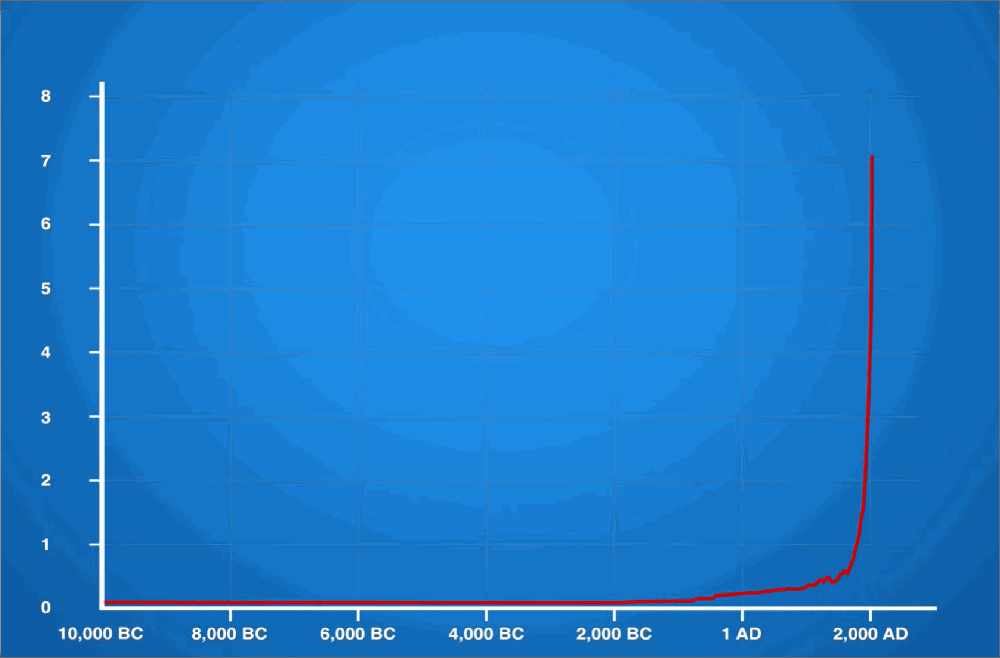 The ‘projection’ in the film…………
The ‘projection’ in the film…………
 ………..and the United Nation’s projections, showing the world’s population levelling off.
………..and the United Nation’s projections, showing the world’s population levelling off.
The film closes with the director’s narration: “We must accept that our human presence is already far beyond sustainability, and all that that implies…we must at long last accept that it’s not the carbon dioxide molecule that is destroying the planet, it’s us”. Humans are the virus.
Whether it was clever timing or sheer luck, the message of the film ties in perfectly with pro-pandemic, anti-human memes. The filmmakers know it, too.
“The fact that within days animals are coming back and the skies are blue tells us that we don’t have to build a million square miles of solar panels or buy a zillion electric cars”, the director told Reuters. “Mother Nature has sent us to our time-out rooms right now and we’re supposed to spend this time thinking about how we messed up things so bad”, executive producer Michael Moore said. Mother Nature sure has a genocidal way of sending messages. Email would have been better.
Most cruelly, producer Ozzie Zehner said in the same interview that “this brief virus period in one week has done more than the environmental movement has done in 30 years to reduce consumption”. As we saw earlier, it’s bullshit. We’re still pumping greenhouse gases into the sky.
Again, the environmental movement hasn’t killed more than 250,000 people in the space of weeks and caused massive unemployment and suffering. I assume the strict ‘don’t do genocide’ standards of the mainstream environmental movement will be one thing these guys will change when they take over.
Later, in an interview on Moore’s podcast, the director says “If this civilisation tumbles down and falls apart on the way down we’ll take everything with us….starving people do horrific things”. There are so many starving people in the world, and they are not doing horrific things. This falsehood, like the film itself, services the view that humanity can only operate in a mode of pure destruction. We have no agency. We are the virus.
Moore is intensely anti-capitalist. In the same way a solar panel made from fossil fuels is unacceptable, the film contends an environment organisation that partners with a corporation is unacceptable too. But their anti-capitalist argument is nowhere near as careful as, say, someone like Naomi Klein (who personally tried to talk Moore out of releasing the film). Klein builds a detailed picture of human-life-enriching alternatives in her critique of capitalism and greenwashing; this film goes to great lengths to avoid doing that.
It is clear they are trying hard to avoid any detail about what a technology-free, capitalism-free climate plan would look like. I think that’s intentional.
Detail or evidence about climate solutions would have neutralised the emotion they were seizing on. If the creators had a vision, the film would have flopped. The presence of a pathway out of the crisis would have allowed for the possibility of human agency.
Since the film’s release, the filmmakers have vaguely suggested a collection of progressive social policies (‘free childcare’), and ideas like ‘planting 1 billion trees‘ or ‘demand better 21st century buses and trains!’ (manufactured without mining or fossil fuels, somehow?). Despite the opportunities to lay out a plan, none exists, beyond randomised platitudes.
And somehow, none have mentioned the other great big non-technological climate solution: keeping fossil fuels in the damn ground and forcing companies to pay penance; presumably because doing so would cause their Youtube stats to nosedive as deniers left in droves.
The cocktail of misinformation, hopelessness and anti-human weirdness in this film has boosted a phenomenon that was rising before the plague. It plugs into a sentiment that has cropped up in spot fires, but now seems to be building into a full blown catastrophe. It is the evil left-wing twin of climate change denial, separated at birth and raised in a progressive family: doomism.
Franzen rising
The presence of people creates climate harm because those people are born into a cage created by the fossil fuel industry.
Executives in these companies are delighted to see blame heaped on humans instead of their sooty shoulders. The cherry on the top for them must surely be seeing their babies – anti-wind and solar myths created by their PR departments in the early 2010s – used towards that goal. The global roar of celebration from every single climate change denial group in the world at this documentary is a clear confirmation of this.
They are celebrating doomism: the umbrella philosophy that provides relief to fraught industries keenly hoping that we won’t notice that escaping their clutches is easier than we think. It contends that there is no point to acting on climate change. It is too late. Humans are unchangeable, or the sky is already wrecked, or both. We must settle in, kick back and commence the great giving up.
It received a boost in 2019, when author Jonathan Franzen argued that “The climate apocalypse is coming. To prepare for it, we need to admit that we can’t prevent it”. This, too, drew on the same tropes that Planet of the Humans does, such as the creation of criteria that excludes the use of technology. It also used misinformation to misrepresent our chances of finding a way out, though at least Franzen was unintentionally hilarious about it: “As a non-scientist, I do my own kind of modelling. I run various future scenarios through my brain”.
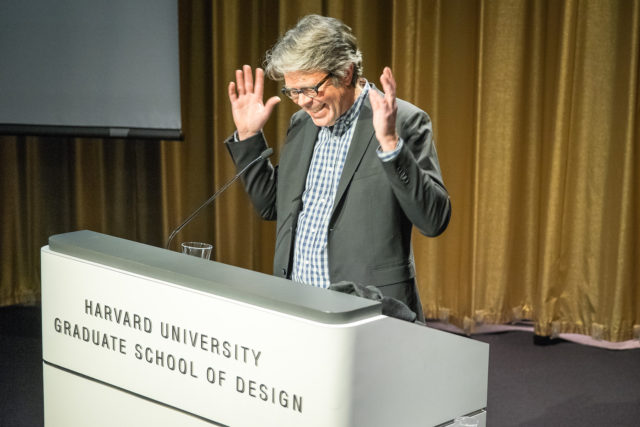 Brain modelling
Brain modelling
Franzen, like the director of Planet of the Humans, Jeff Gibbs, is a conservationist hailing from an era when climate didn’t dominate the environment movement. They are pissed off the topic has inflated to fill every space. “I’m heartened to see your inclusion of biodiversity”, said Gibbs, in an interview with Extinction Rebellion’s co-founder Clare Farrell, straining to not think too hard about the technological implications of the group’s net zero by 2025 target.
It’s hard not to feel like they’d prefer if we gave up on that problem and worked on more ‘local’ conservation efforts instead. It is a noble concern, but because it must happen at the exclusion of all other things, it translates into a destructive loathing for renewable energy and a need to exaggerate its environmental impact.
“Every renewable-energy mega-project that destroys a living ecosystem—the “green” energy development now occurring in Kenya’s national parks, the giant hydroelectric projects in Brazil, the construction of solar farms in open spaces, rather than in settled areas—erodes the resilience of a natural world already fighting for its life”, wrote Franzen. It may as well have been the droning narration on Planet of the Humans.
You can see why those irked by climate’s prominence plagiarise so deeply from climate denial; both are essentially working towards pushing this issue back into irrelevance. Both doomism and denialism share a seething hatred of renewable energy: the prospect of effort and human will resulting in any real action is a grossly unacceptable attack on the drive to surrender.
The great giving up draws on deception to create a thick, choking fog of helplessness. It copies and pastes memes originating from the PR departments of corporate carbon titans. It predicts humanity will grow vicious and breed wildly. It frames coronavirus as our well-deserved punishment. It builds a bed of bullshit to reach its conclusion: forget about climate change, and go back to worrying about your backyard, instead.
There was no worse time to burn a hole in this fabric
Planet of the Humans is an act of destruction that comes at an extremely sensitive moment. In late 2019, the climate movement was picking up steam. The youth climate strike movement was expanding rapidly and growing up, culminating in history’s biggest ever climate marches. Greta Thunberg’s rallying cry was simple: technology, sustainability, efficiency and ‘hope’ are all insufficient platitudes unless they’re paired with action.
“Now we’re almost at the end of my talk, and this is where people usually start talking about hope, solar panels, wind power, circular economy, and so on, but I’m not going to do that”, she’d said in a 2018 talk. “The one thing we need more than hope is action. Once we start to act, hope is everywhere. So instead of looking for hope, look for action. Then, and only then, hope will come”.
As this call for action began to slowly seep into the corporate and political system that had safely ignored action for so long, a pandemic hit the world. It has badly reduced public interest in climate, but the recovery process can become a conduit for the systemic and deep change so badly needed. The climate strikes, Australia and California’s climate-intensified bushfires, and now the vast, terrifying global reset of coronavirus have all made this the most intense time in the history of climate action.
Michael Moore, Jeff Gibbs and Ozzie Zehner arose at this moment to pioneer a left-wing anti-renewable movement coated in a thick sheen of hopelessness. They’re trying to replicate environmentalism’s opposition to nuclear, but without a Chernobyl or Fukushima to lean on they’re forced to reheat decade-old memes instead.
Thunberg’s message of action only works when paired with agency. We must know that we have no fate. We are not doomed, and we are not destructive, at least not by default. Our presence is not toxic, and our hearts are not black. We are not cockroaches, or a fucking virus. What good is Thunberg’s plea for action, when so many are celebrating the use of misinformation to spread helplessness?
We are capable of finding a way out of the fossil-fuelled cage we were born into, without leaning solely on a single solution. Millions of smart, brave people are on the case, and every day they are forced to strike a balance between attaining goals and retaining principles. These heart-scarring sacrifices are trivia to the people who made Planet of the Humans.
We can put blood sweat and tears into repairing the broken systems that brought about this cataclysmic global threat, repairing our relationship with our only home and profoundly enriching human life at the same time. It is pseudo-serious fatalistic bullshit to say we can’t.
The challenge is so complex, involving alliances between so many natural enemies that only cohesion, tolerance and kindness can sustain a response. The people who made this film dropped a grenade in the middle of a fragile coalition at the worst possible time, and they’re beaming with pride, oblivious to the carnage.